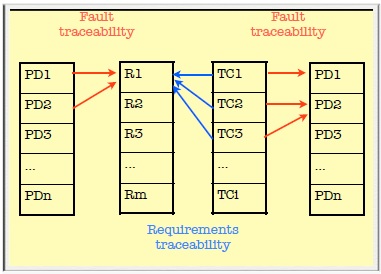Requirement traceability is about ensuring that each requirement does indeed have test case(s). So after we design test cases, we map test cases to requirements to ensure that all the requirements are indeed being validated. This is typically used as a measure of test adequacy.
Let us consider a situation wherein there is exactly one test case for each requirement. Now are the test cases adequate? No! Requirement traceability is a necessary condition for test adequacy but not sufficient.
Given that the Requirement could have the PDTs that have been mapped earlier, let us map the designed test cases to the PDTs. The intent of this is to ensure that the designed test cases do have the power to uncover the hypothesized defects.
In addition to requirements traceability, it is expected that the test scenarios and the corresponding test cases are indeed traced to the potential types of defects that they are expected to uncover. This is termed as fault traceability.
Fault Traceability in conjunction with Requirements Traceability makes the condition for test adequacy Necessary and Sufficient.
If we had a clear notion of types of defects that could affect the customer experience and then mapped these to test cases, we have Fault Traceability). This allows us to be sure that our test cases can indeed detect those defects that will impact customer experience.
